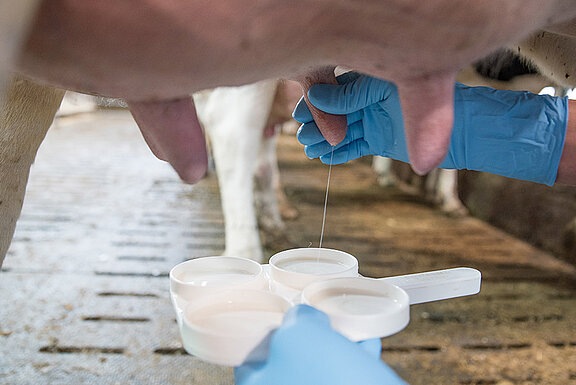Infections with highly pathogenic avian influenza virus subtype H5N1 (HPAIV H5N1) clade 2.3.4.4b have been detected in at least 33 dairy cow herds from 8 states in the USA. The actual extent of the spread in infected dairy herds in the USA probably exceeds these figures. The US authorities are now also reporting PCR evidence of H5N1 virus genome in pasteurised milk from supermarkets, i.e. contaminated milk has also entered the food chain. But no infectious milk has yet been found in the food chain. However, until further clarification in the USA, the consumption of unpasteurised milk (raw milk) and products made from it is strongly advised against.
There is no evidence of similar infections outside the USA. Initial orientating tests of 1000 bovine serum samples from Germany by the Friedrich-Loeffler-Institut (FLI) did not reveal any evidence of H5N1 infections; these and other random tests also serve to establish and validate sensitive and specific diagnostics.
A well-founded assessment of the situation in the USA is urgently required, but remains incomplete due to a lack of diagnostic and epidemiological data. The available information points to a possible single entry of H5N1 into a cattle farm in Texas, from which uncontrolled animal transport led to the further spread of the virus. How the virus spreads within affected farms remains unclear. As investigations have revealed high virus loads in the udder and therefore also in the milk, transmission through the use of milking equipment is particularly conceivable. Transmission from cow to cow, e.g. through droplet infection or direct contact, also does not appear to be ruled out. However, only low virus loads have apparently been detected in nasal swab samples to date.
The udder of infected dairy cows appears to be at the centre of the infection event and appears to be particularly well suited to the spread of the virus. How the initial infection of dairy cows in the USA occurred is still unclear. The jump of an avian influenza virus from one species to another is usually associated with the transmission of large amounts of virus. Since the first appearance of the precursors of today's circulating H5N1 HPAIV 27 years ago, there has been no evidence of H5 HPAIV circulating in ruminants worldwide.
FLI scientists also investigated the susceptibility of cattle to the then circulating H5N1 virus in the context of the 2006-2008 H5N1 avian influenza outbreak in Germany, but found only a very low risk of infection for the animals. However, no lactating cows were tested at that time. However, the cattle developed antibodies and the FLI recommended that the situation be monitored further.
HPAIV H5N1 is an epizootic and potentially zoonotic agent. Strict precautionary measures would be taken immediately in the event of cases in dairy herds in Germany. These measures are designed to contain the potential spread of the disease as effectively as possible and to protect humans from infection. Possible measures range from transport restrictions (milk, animals) to herd closures and extensive sampling.
In the current situation, it is particularly important to be vigilant and take targeted samples in the event of suspected cases or well-founded indications of possible exposure.


